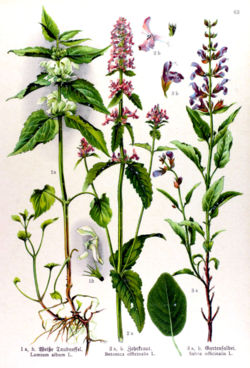| Betonica | |
|---|---|
 | |
| Betonica officinalis | |
| Scientific classification | |
| Kingdom: | Plantae |
| Clade: | Tracheophytes |
| Clade: | Angiosperms |
| Clade: | Eudicots |
| Clade: | Asterids |
| Order: | Lamiales |
| Family: | Lamiaceae |
| Genus: | Betonica L. |
Betonica is a genus of the plants in the family Lamiaceae. [1]
Betonica was until recently usually included in the genus Stachys as a subgenus Stachys subg. Betonica (L.) Bhattacharjee, but was separated at genus rank from Stachys when a detailed morphological examination showed clear consistent differences in both the foliage and flowers, valid at a higher rank than the previous treatment as just a subgenus. [2] This has been confirmed by genetic study, which shows Betonica is separate from Stachys and more closely related to the hemp-nettles Galeopsis . [3]